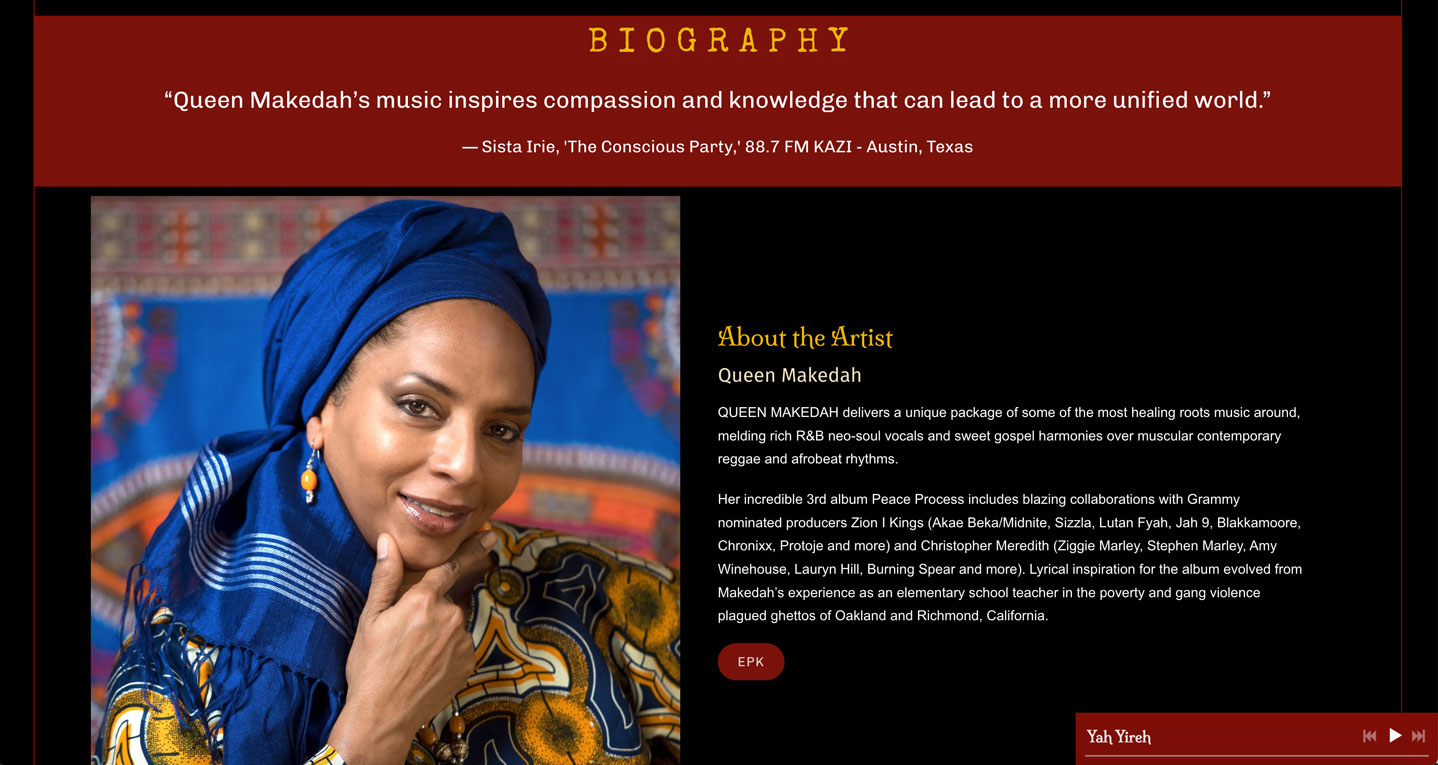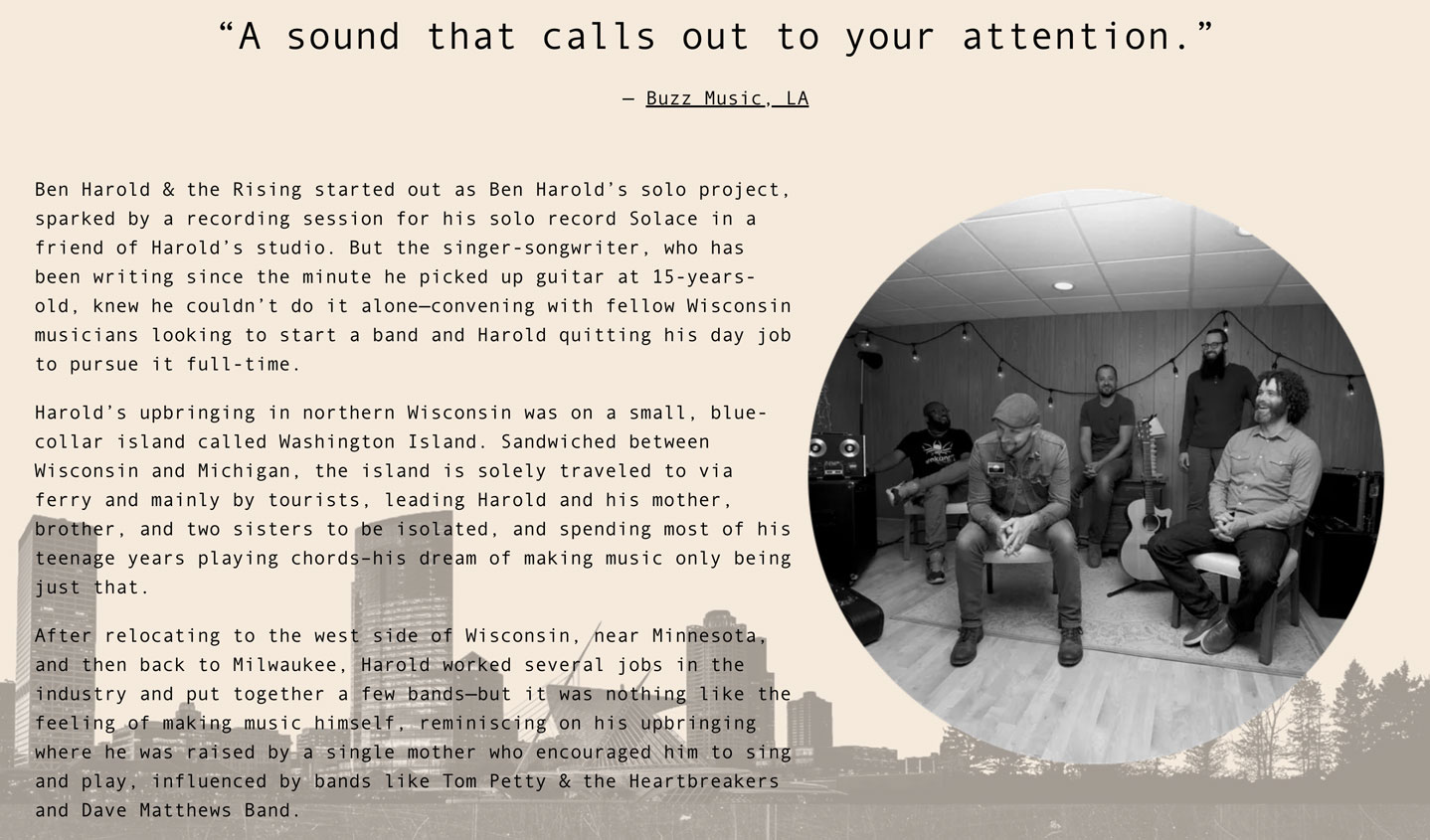

One of the most important pages on your music website is your bio page. Let's face it - although you may be great at composing melodies and lyrics, it’s hard to write about yourself. Writing a great musician bio is not an easy thing to do, but it’s a really important way to make your band appear professional.
A great musician bio will create the first impression of you to many of your website visitors, so make it a good one. It will help convert your visitors into fans, as well as give music reviewers and media a sense of who you are.
So how do you go about writing that perfect musician bio? These elements will help you write an effective bio that details your music and your background in a concise and inviting way.
The toughest part about writing your musician bio is getting started. Make a few notes on a piece of paper to begin. Jot down your name, and where you’re from. Add what your music sounds like, as objectively as you can, and then write down your influences.
This will help you shape a sentence or two as an introduction. You’ll want it to be engaging, but concise. It’s easy to go too long here, so think about how you might quickly introduce yourself to someone who has never met you or heard your music before.
Keep your tone in mind as you write your bio’s introduction. Depending on your style of music– and your personality–you may want to inject some humor into your bio. You may also want to write more formally.
Include some relevant background information in your bio, including your musical history, but again: keep it short. You want to be sure to keep your visitors engaged - not lose them with lengthy paragraphs of text.
Write down your musical history and education, and choose just a few relevant parts to incorporate into your bio.
As a note, make sure to write your musician bio in the third person. This will make it quick to scan and understand, and will help with your website’s search engine optimization. It also allows media, bloggers, bookers, or venues to simply copy and paste your bio if they need it.
Although most of your fans will already be familiar with your music, a blogger or journalist may not yet have a sense of your sound. Add a quick description that talks about what your music is like.
It may be hard to fit your sound into a genre, but try to use a few familiar words so that people can place you. This will help someone reading your bio want to also listen to your music.
Talk a bit about what you’re currently up to with your music. Have you just gone into the studio? Released a single? Co-written a song with another artist?
Choose the most relevant and recent thing that you’ve done with your music, and add that to your musician bio.
If you’re in a band, you can write out the full band bio at the top of your page. Beneath it, you can add text talking about each band member. Include an image with each musician bio to create visual interest.

Bandzoogle gives you all the tools you need to create your own unique band website, including responsive templates and commission-free selling tools.
Think about everything you’ve accomplished with your music. Have you opened for a well-known band, or played a big festival? Have you had success on streaming music platforms, charted on college radio, or been nominated for an award?
Make a list of your achievements. Then pick two or three of the most impressive items, and include those in your musician bio. One of these items should be pretty recent, to show that you’re an active musician.
Don’t exaggerate or embellish in this part of your bio–stick to the facts, but present them in a positive way.
A quote from a reviewer is a nice way to show that others are talking professionally about your music. Look for a quote that will enhance your musician bio–something that helps to describe your sound, or your latest album. It’ll lend some authority to your musician bio.
A quote can be a skillful way to emphasize your accomplishments, or your new music. It could be from a venue owner, a musician you’ve worked with, an album review, or someone in the media.
See where it fits in seamlessly–a quote about your new album will work when talking about your music to date, or a venue quote will help describe your live show with sold out numbers.
If you don’t have a quote, that’s ok–just keep it in mind for the future. You could reach out to someone you’ve connected with professionally to see if they can provide you with something you can use in your bio.
Your musician bio is an important part of your music website–it can let new visitors know who you are, and offers industry professionals something to use in their promotions. Add your bio to a couple of places on your website to make it easy to find.
You can place a short elevator pitch on your ‘Home’ page, and use your full, most in-depth musician bio on your ‘About’ page , including some downloadable press-quality images there as well.
You’ll also want to include a version of your bio in your electronic press kit (EPK) . You can use the short version, or add multiple versions for press and industry to choose from.
Make a note to update your bio in these places with any new projects, releases, collaborations, or upcoming tours. You’ll want to be sure to add new accomplishments as your career moves forward. A stale, outdated musician bio won’t serve you well, so make sure to refresh it regularly!

With all this in mind, it can still feel overwhelming to take every piece of advice and condense it into a readable musician bio. So, a sample musician bio might go a bit like this:
Quick introduction. Mention your name, your style of music, and your influences.
Next, move to your background. Mention how long you’ve been playing, the bands you’ve played with, and a notable accomplishment.
End with what you’re doing currently. This could be playing shows, recording, writing, or a mention of your latest album.
Below are a few examples of great musician bios to give you some inspiration.
Contemporary R&B / gospel artist Queen Makedah uses color and sections to give her musician bio a streamlined look. It’s got depth, with plenty of quotes and information, but is easy to scan, and enjoyable to read:

Singer/songwriter Ben Harold has created a bio that emphasizes his musical history and achievements, telling his story in a way that makes you want to read it. His bio text floats over the background imagery, lending his musician bio a balanced look:

Jazz guitarist Sam Wilson has created a musician bio that’s a great example of combining all of the important elements. From a description of her style, to her accomplishments, and a mention of her new, award-winning album, her bio covers all of the bases:

As a long-time musician, Eric Essix has written a bio that tells his story in detail. It’s interesting for fans to see where he has come from, and what he is doing now. Then he’s also included a succinct musician bio on his EPK page that sums up his latest project. It’s easy for industry to skim, with a button leading back to his full website for extra information:

Once you’re done writing your musician bio, check your spelling. Then check it again. Be sure there are no errors or typos! It might even help to read it out loud a couple of times to be sure it flows well and makes sense. Consider passing it along to a few friends to get their eyes on it, too.
You can use these elements to create an effective musician bio. Use it in multiple places on your music website , and don’t forget to keep it up to date as your music career moves forward. It will serve you well if it’s up to date and compelling.